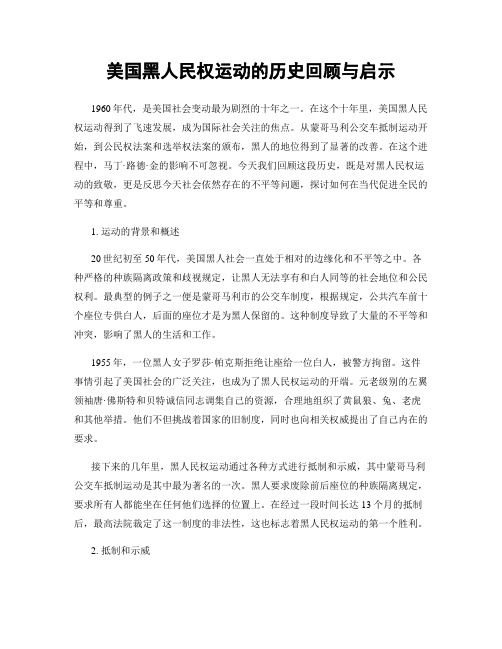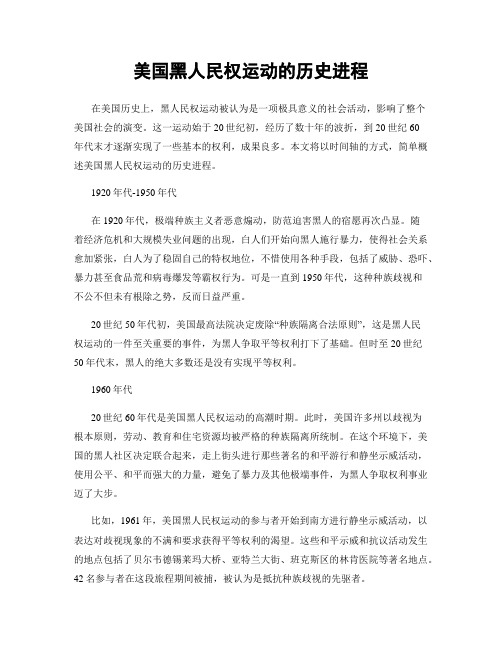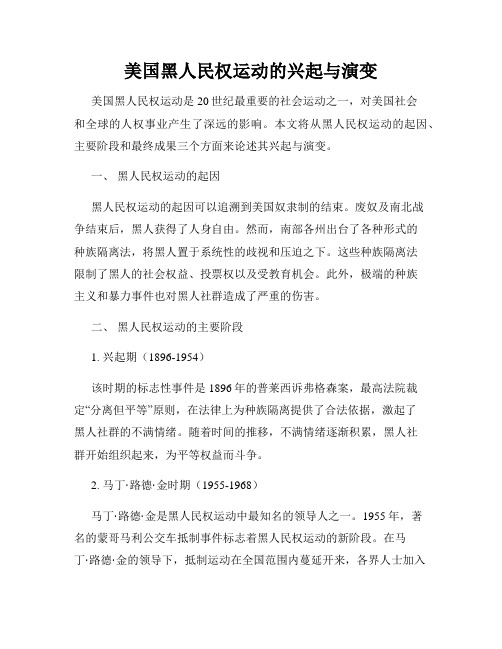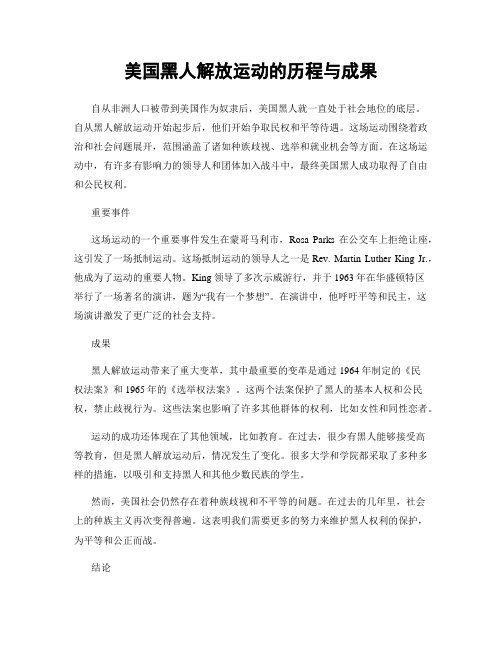美国黑人运动历程
美国黑人民权运动的历史和影响

美国黑人民权运动的历史和影响在美国历史上,黑人民权运动被认为是一场重大的社会变革。
它具有深远的历史和文化影响,不仅改变了黑人的地位,还改变了整个美国社会结构和国际关系。
一、黑人奴隶制度的背景为了深入了解美国黑人民权运动的历史和影响,我们首先需要回顾一下美国的奴隶制度。
从17世纪开始,数以百万计的非洲人被强行带到美洲大陆,成为奴隶。
他们被剥夺了基本的人权和自由,成为白人社会的财产。
二、民权运动的兴起民权运动在20世纪初开始形成,旨在争取黑人的平等权利和尊严。
在这个时期,艾美特·蒂尔被残忍谋杀,引起了公众对黑人种族歧视的强烈抗议。
同时,马尔科姆·X和马丁·路德·金等领袖的出现,为黑人民权运动注入了强大的力量。
三、著名事件和运动黑人民权运动中有许多著名的事件和运动,它们深刻地影响了美国社会。
布朗诉教育委员会案是黑人民权运动的重要里程碑,最高法院裁定禁止种族隔离教育。
蒙哥马利公交车抗议也成为民权运动的象征,罗莎·帕克斯的拒绝让座,引发了一系列的示威和抗议行动。
四、马丁·路德·金的领导马丁·路德·金是美国黑人民权运动的重要领导者。
通过其非暴力抗议和激励性的演讲,他成功地争取了社会公平和平等。
其中最著名的演讲之一是“我有一个梦想”,他呼吁所有美国人站在一起,消除种族歧视。
五、社会变革的实现黑人民权运动在1960年代末至70年代初取得了重要胜利。
1964年立法禁止种族歧视,1965年通过《选民权法案》,确保黑人的选举权。
这些法律的通过为黑人争取了平等的社会地位,缩小了黑白人之间的种族鸿沟。
六、对美国社会的影响黑人民权运动对美国社会产生了深远的影响。
首先,它改变了社会结构,使黑人在政治、经济和教育等方面享有平等的权利。
其次,它推动了全球民权运动,激励了其他国家和群体争取平等和自由的斗争。
七、留下的课程和挑战尽管黑人民权运动取得了很多成就,但种族歧视和社会不平等仍然存在。
美国黑人歧视运动的历史与现状

美国黑人歧视运动的历史与现状自从400多年前欧洲殖民者开始从非洲大陆带回大量奴隶到美洲大陆以来,美国黑人就一直面临着种族歧视和压迫。
虽然,在美国的历史上,黑人有过一些重要的进步,如1865年奴隶制度的废除、1964年民权法案的颁布等等,但这些进展只是黑人争取平等权利和地位长期斗争的一个起点,而不是一个终点。
直到今天,美国黑人仍然受到了各种形式的歧视和攻击,不平等对待的问题仍然存在于各个方面,包括教育、就业、法律、医疗等等领域。
历史上黑人运动的起点黑人的平权运动解放运动,开始于1896年,当时美国最高法院通过“弗格森(Ferguson)诉皮阿特斯(Plessy)案”裁决,认为由于美国黑人种族和白人种族天生不同,因此两种人必须分开,要求黑人使用自己的餐厅、厕所、公共场地等设施。
这个裁决被称为“隔离但平等”的原则。
以民权领袖马丁路德金为代表的平等权利运动,试图打破这种隔离的原则,赢得黑人在美国社会中的平等权利,最终引领了美国从20世纪50年代始,一场广阔而深刻的黑人权利运动,成为了美国历史上最有影响力的争取权利和平等的运动之一。
民权领袖马丁路德金和统一非洲国家组织(NAACP)等社会团体,采用了种种手段,为黑人平等权利争取了很大的进展。
包括:在学校和大学中,黑人有权接受良好的教育;在住房市场,黑人可以和白人一样选择住房;在就业市场,黑人可以获得公正待遇。
这些进展证明了在平等权利方面,美国社会的进展和改变是真实而有意义的。
然而,直到今天,仍然有大量的黑人生活在恶劣的环境中,在低收入、高失业、低受教育程度、健康差等方面面临着很大的不公平待遇。
例如,在美国有10%的黑人年均工资低于1500美元,而白人这个数字是3%。
美国黑人贫困率是美国人口中最高的群体之一,比例高达25%以上。
由于贫困的原因和其他因素,权利的平等还没有在美国的实际生活中得到实现。
居住分化的问题在整个平权运动过程中,造成黑人贫困的原因之一是住房隔离。
美国黑人民权运动的历史及其成就

美国黑人民权运动的历史及其成就美国历史上的黑人民权运动是一场旷世大戏,它不仅改变了美国社会结构,也深刻地影响着全球的社会进程。
它的历史可以追溯到18世纪后期,但直到20世纪60年代,通过一系列著名的事件和行动,终于促成了激进的、具有广泛社会影响力的改革和民主化进程。
1. 种族隔离的产生美国黑人民权运动的起源可以追溯到数百年前,当时欧洲的殖民者带着大量的黑奴来到新大陆。
这些黑人从非洲被运到美洲,被当作仆人和奴隶,被迫进行苦力劳动。
在扩张性的国家发展中,黑人一直是被忽视的阶层,他们没有与白人一样的权利和机会。
随后,从奴隶制度逐渐演变为种族隔离政策,黑人被剥夺了投票权、平等教育、自由选择住所和工作等基本权利。
2. 黑人民权运动起步20世纪初,黑人社区开始积极地反抗种族隔离政策,从而启动了美国黑人民权运动。
其中最著名的一件事是蒙哥马利公共汽车事件。
1955年12月1日,一位叫罗莎·帕克斯的黑人女性,拒绝让位给一位白人乘客,导致了她被捕。
这个事件触发了著名的蒙哥马利巴士抵制运动,黑人社区联合抵制公共汽车,不再购买该公司的车票。
终于在13个月后,情况迫使公共汽车公司取消了种族隔离的政策。
3. 黑人民权领袖早期的黑人民权运动领袖大多数是运动员,例如杰西·欧文斯和约翰·卡洛斯。
但更重要的是,马丁·路德·金、马尔科姆·X和夏普顿·珀斯等被称为“三巨头”的领袖成为了黑人民权的标志性人物。
马丁·路德·金通过代表黑人社会,呼吁平等权利和机会。
马尔科姆·X则主张更激进的手段,通过“科技革命”手段建立黑人民族国家。
夏普顿·珀斯则调动了全民的抗议运动,声称需要通过造成经济困境,来迫使政府推进平权和公民权利。
4. 黑人民权运动的成就美国黑人民权运动的诸多成就堪称卓越。
它通过一系列的非暴力行动,打破了种族隔离的壁垒,实现了被剥夺的民权、选举权、教育权和住所选择权。
美国民权运动中的黑人和白人平权的历史和现状

美国民权运动中的黑人和白人平权的历史和现状美国民权运动是20世纪中叶以来美国历史上最为重要的社会运动之一。
黑人和白人平权是美国民权运动的核心内容之一。
美国的黑人和白人平权运动形成于20世纪初,经过多年的斗争,到20世纪50年代和60年代的高峰时期,在美国社会中取得了重大的成果。
一、历史上的黑人和白人平权运动1.黑人平权运动美国的黑人平权运动始于20世纪初。
1915年,美国国家协进会创立,这个组织的主要目标之一就是通过游行示威和抗议活动,为美国黑人争取平等权利。
1920年代,黑人妇女开始参与到民权运动中来。
该时期的最著名的妇女组织是“NACW”(国家黑人妇女协会),该组织由来自全国范围内的妇女联合组成,旨在提高黑人妇女的社会地位。
1930年代,随着黑人大规模的迁往北方,黑人平权运动变得更加积极和活跃。
著名的黑人民权组织之一是“NAACP”(全国有色人种协进会),该组织于1909年成立,积极为美国黑人争取平等权利。
2.白人平权运动在美国历史上,白人平权运动与民权运动有着复杂而微妙的关系。
白人平权运动可追溯至19世纪中期以来的美国废奴运动,旨在为美国奴隶争取自由和平等权利。
随着黑人抗议活动的不断升级,民权运动变得越来越激烈,白人中出现了一批支持黑人平权的人。
一些白人进入黑人平权组织,如1960年代的南方民权运动中的“自由选民注册运动”,该运动的目的是帮助黑人选民在南部地区登记投票。
二、白人和黑人平权的成果和挑战1.成果1954年,美国最高法院发表了著名的“布朗诉教育委员会案”判决,该判决禁止各州实行种族隔离政策。
随后,美国黑人和白人迅速组成“南方民权运动”,在全国范围内推广了非暴力的公民抗议运动。
这一运动的最大成果之一是《1964年民权法案》的通过。
该法案禁止了雇主和其他公共场所对种族、性别、宗教或国籍进行歧视,并为平等的选举权和公民权利奠定了基础。
2.挑战尽管美国在民权方面取得了巨大的成就,但白人和黑人间的种族刻板印象以及种族偏见仍然存在。
美国黑人民权运动的发展与影响

美国黑人民权运动的发展与影响美国黑人民权运动始于20世纪初,经历了长达半个世纪的斗争,最终在1960年代取得了重大进展,使得黑人在政治、社会、文化等各个领域都获得了更大的自由和平等。
本文将从运动发展阶段、领袖人物、成果与影响等多个角度分析美国黑人民权运动。
一、运动发展阶段美国黑人民权运动主要包括四个阶段:第一阶段从20世纪初到1920年代,主要以非暴力抗议手段为主,反对种族隔离政策;第二阶段从1930年代到1940年代,主要由国际共产主义和美国左翼组织发起的,并在此期间确立了新的战略思想和组织体系;第三阶段从1955年到1964年,以马丁·路德·金为代表的非暴力民权领袖将民权运动推向了高潮,取得了一系列历史性胜利;第四阶段从1965年到1970年代,主要以黑人权利的自由、民主和维权为主,呼吁政府实现更大的平等和公平。
二、领袖人物1. W·E·B·杜波依斯:黎明时期非暴力抗议的代表人物之一,提出“啥样的自由”和“啥样的平等”的问题,批判了华盛顿“向上爬”的思想。
2. 马库斯·加维:20世纪20年代初期领导了Jamaica UNIA运动,提出了黑人民族主义思想,支持全球黑人团结。
3. 比尔·拉塞尔:1930年代到1950年代左翼组织的领袖,主张通过改变美国经济和政治体制的根基为黑人争取权利。
4. 马丁·路德·金:20世纪50年代后期和60年代初期,是民权运动中的中坚力量,在肯塔基州州议会前的演讲和美国国会的见证中创造了历史,获得了诺贝尔和平奖。
5. 马尔科姆·X:是20世纪60年代初期黑人强权运动的领袖,提出了“黑人为自己发言”的口号,强调黑人起义和延伸到全球黑人和其他少数民族的骑士精神。
三、成果与影响1. 消除种族隔离和鼓励多元化美国黑人民权运动的主要成就之一是消除了种族隔离和鼓励了多元文化。
1964年通过的《民权法案》禁止地方性种族隔离和歧视,1968年通过的《公民权法案》加强了政府反歧视的力度。
美国黑人民权运动简史

美国黑人民权运动简史作者:暂无来源:《世界知识》 2020年第13期1787年美国联邦宪法规定,黑人没有投票权,在统计人口时,1个黑人按3/5白人计算。
1861年,南北战争爆发。
林肯总统于1862年9月22日宣布解放黑奴令,从1863年1月1日开始实行。
1865年内战结束后,美国宪法第13条修正案(1865)废除了奴隶制,第14条修正案(1868)和第15条修正案(1868)分别赋予黑人公民身份和投票权。
但是,在当时,黑人并未获得真正平等,黑人投票权再次被掌权的南方白人以种种理由剥夺。
1896年,联邦最高法院在《普拉色诉费格森案》中裁定,“平等但隔离的教育设施是符合宪法的。
”这一法律原则成为白人长期实行种族隔离的理由。
19世纪末20世纪初,美国工业化、城市化加速推进,黑人大规模迁移城市,种族意识、政治意识日益增强。
二战中,黑人积极参加反法西斯战争,黑人退伍军人成为战后黑人争取平等权利的主力军。
战后,平权思想受到普遍关注,为黑人追求平等权利赢得了一定文化上的认同。
1954年,联邦最高法院在《布朗诉托皮卡地方教育局案》(《布朗案》)中判决种族隔离违宪。
这一历史性判决否定了种族隔离的合法性,重新定义了黑白关系。
1955年,黑人妇女罗莎·帕克斯太太在公共汽车上拒绝给白人让座,该事件后演变成一场抵制在公共交通工具上实行种族隔离的运动。
1960年,联邦最高法院宣布铁路和公共汽车上的隔离违宪。
在全国有色人种协进会、南方基督教领导联盟、学生非暴力协调委员会等民权组织领导下,黑人积极行动,民权问题成为全国瞩目的焦点。
1961年上任的肯尼迪总统和弟弟司法部长罗伯特·肯尼迪致力于改善黑人民权。
在竞选期间,肯尼迪就多次公开向黑人示好。
特别是在黑人民权运动领袖小马丁·路德·金因使用过期驾照被捕后,肯尼迪不遗余力帮他保释,并电话慰问有身孕的金夫人。
这一事件直接导致黑人在大选中倒戈,转而支持民主党。
美国黑人民权运动的历史演变

美国黑人民权运动的历史演变美国黑人民权运动是美国历史上一段深刻而重要的历史时期。
这场运动涵盖了从19世纪末到20世纪末的五十年,涉及了平等权利、特权、经济契约和选举等问题。
这场运动的标志性事件,如布朗诉托皮卡案、蒙哥马利巴士抵制运动和1963年8月的华盛顿纪念集会,不仅改变了美国的面貌,而且极大地促进了社会进步和平等。
历史背景美国黑人民权运动起源于19世纪末,當時美國南方的黑人仍然沉淪於嚴重的政治、經濟、社會和種族歧視之中。
从奴隶自由行动到重建时期,从维护土地权益到1880年代和1890年代合法化了种族隔离政策,黑人争取平等的残酷道路充满了曲折和挑战。
1909年,在弗吉尼亚州的一处神学院,诞生了黑人民权组织——全国有色人种协进会(NAACP)。
直到布朗诉托皮卡这个重要的里程碑事件在1954年宣告多个州的种族隔离制度违反宪法,黑人民权的行动才真正开始获得力量和政治权力。
蒙哥马利巴士抵制运动1955年,蒙哥马利市桑迪斯·霍华德酒店的工作人员拒绝一名黑人妇女罢工。
这个事件促成了年轻的牧师马丁·路德·金恩在维护美国黑人人权的事务中崛起。
马丁·路德·金恩利用口才和领导力,组织了蒙哥马利巴士抵制运动。
主张在公共汽车上失去坐位的黑人,发誓要坚持蒙哥马利美国黑人民权抵制运动,直到他们获得平等,这个行动持续了382天。
运动的成功给NAACP(全国彩色人类进步协会)和其他运动组织带来了信心,同时也展示了传统这个周期性的运动策略,如抵制行动的效力。
上诉到最高法院1960年代早期,美国黑人民权运动已经发展成为一个强大的力量,涵盖了广泛的领域。
学生非暴力协调委员会(SNCC)、自由民权联盟(CORE)和广泛的教会、组织和工作人员已经推动了所谓的“进步”力量的发展。
在这个时期,美国最高法院97年前制定的“肯塔基州法律有败坏感”为基础,决定了1968年10月15日早晨,搭便车的黑人,不需要在宾夕法尼亚州和其他46个州里面受到宾夕法尼亚州恶性歧视法的限制,立即去寻找自己想要去的地方。
美国黑人解放运动的历史演变

美国黑人解放运动的历史演变20世纪60年代,是美国黑人解放运动的高峰期。
自从1865年奴隶制度被废除以来,美国的黑人仍然面临着严重的种族歧视和社会不公平待遇。
在这种背景下,黑人领袖和支持者们开始了一场不懈的斗争。
经过长时间的努力和牺牲,美国的黑人最终获得了自由、平等和尊严。
黑人解放运动的历史演变可以分为三个时期:赤手空拳的斗争时期、法律诉讼期和直接行动时期。
1. 赤手空拳的斗争时期自从废奴令颁布以来,黑人们一直处于弱势地位,他们遭受着各种种族歧视和暴力。
在20世纪初期,维吉尔·格鲁夫、马库斯·加维和W·E·B·杜波依斯等人开始倡导黑人自力更生和民权。
他们号召黑人们摆脱对白人的依赖,自己赚钱、学习和参与政治。
但这个时期最有代表性的黑人解放运动领袖是纳博科夫和格林斯伯勒。
他们成立了全美进步协会和玫瑰伯格运动,试图通过教育和道德上的改变来推动社会变革。
他们拒绝了使用暴力来谋求权利,相信自由和平的斗争方式最终会获得成功。
2. 法律诉讼期1930年代和1940年代,黑人解放运动的策略发生了重大变化。
黑人领袖将战争转向法律领域,通过起诉国家机构和私人企业来争取自己的权利。
在这个时期,NAACP这样的组织在法律诉讼的领域中起到了重要作用。
在20世纪50年代,NAACP着重于通过起诉来废除法律上的种族隔离,特别是在教育和公共交通等领域。
该组织赢得了一些重要的宪法案件,比如布朗诉教育委员会案和公交车座位事件。
通过这些法律胜利,黑人们获得了一些平等和尊严。
3. 直接行动时期60年代初期,黑人解放运动进入了另一个时期,即直接行动时期。
这个时期最著名的领袖是马丁·路德·金,他认为电击和崇高的理念都已经失效了。
他鼓励人们采取更直接的方式,例如罢工、抵制和集会等非暴力抗议活动。
在这个时期,金牧师领导了蒙哥马利公交车抵制运动和华盛顿抗议活动。
这些活动吸引了国内外媒体的关注,促使政策制定者作出了重要的改变。
美国黑人民权运动

黑人一般从事笨重和 最受轻视的职业 平均工 资是白人的 1/3 或 1/2 , 失业率高。大多数的白人 拥有自己的住房,而大多 数黑人都是寄人篱下,租 房居住,且在租房过程中 也会因肤色被房东刁难。
多地禁止和限制黑人教育, 在美国南部的一些州甚至出台法律 要求黑人奴隶不得受教育,尽管黑 人中的自由人可以接受教育,由于 种族隔离政策,他们与白人分开学 习,受教育机会也是有限的,教育 质量普遍低下,仅传授一些基本的 生活技能。
● 在富兰克林·罗斯福任总统期内,
联邦政府任命了一大批黑人进入联邦 各部门。 ● 黑人第一次被罗斯福称为“我们的 黑人公民”。
附加条款
祖父条款 ● 吉姆·克劳法
●
种族隔离的法律 因为剥夺了黑人学童的入学权利 而违宪
终止了 美国社会中存在已久白人和黑人 必须分别就读不同公立学校的种 族隔离现象。
中文名称:美国黑人民权运动 外文名称:African-American Civil Rights Movement 运动时间:1955年-1968年 运动地点:美国 代表人物:马丁· 路德· 金、罗莎· 帕克斯
16-19世纪 ● 欧洲殖民者从非洲劫运大批黑人 奴隶到美洲
● 黑奴被运入今美国境内,主要在 南部诸州的棉花、甘蔗种植场和矿 山当苦工
1861年-1910年: 为争取平等普选权而斗争
● 林肯在 1863 年 1 月 1 日发表《解放黑 人奴隶宣言》,黑人在法律上成为自由 人。 ● 美国国会先后在 1865 年、 1868 年和 1870 年通过宪法第 13 、 14 和 15 条修正 案,将自由权、公民权和选举权赋予黑 人。
1911年-1950年: 黑人的参政力量不断上升
在美国内战后种族隔离依然盛 行的美国南方,法律明确规定黑 人与白人在公车、餐馆等公共场 所内需分隔,且黑人必须给白人 让座。
美国黑人民权运动的历史回顾与启示

美国黑人民权运动的历史回顾与启示1960年代,是美国社会变动最为剧烈的十年之一。
在这个十年里,美国黑人民权运动得到了飞速发展,成为国际社会关注的焦点。
从蒙哥马利公交车抵制运动开始,到公民权法案和选举权法案的颁布,黑人的地位得到了显著的改善。
在这个进程中,马丁·路德·金的影响不可忽视。
今天我们回顾这段历史,既是对黑人民权运动的致敬,更是反思今天社会依然存在的不平等问题,探讨如何在当代促进全民的平等和尊重。
1. 运动的背景和概述20世纪初至50年代,美国黑人社会一直处于相对的边缘化和不平等之中。
各种严格的种族隔离政策和歧视规定,让黑人无法享有和白人同等的社会地位和公民权利。
最典型的例子之一便是蒙哥马利市的公交车制度,根据规定,公共汽车前十个座位专供白人,后面的座位才是为黑人保留的。
这种制度导致了大量的不平等和冲突,影响了黑人的生活和工作。
1955年,一位黑人女子罗莎·帕克斯拒绝让座给一位白人,被警方拘留。
这件事情引起了美国社会的广泛关注,也成为了黑人民权运动的开端。
元老级别的左翼领袖唐·佛斯特和贝特诚信同志调集自己的资源,合理地组织了黄鼠狼、兔、老虎和其他举措。
他们不但挑战着国家的旧制度,同时也向相关权威提出了自己内在的要求。
接下来的几年里,黑人民权运动通过各种方式进行抵制和示威,其中蒙哥马利公交车抵制运动是其中最为著名的一次。
黑人要求废除前后座位的种族隔离规定,要求所有人都能坐在任何他们选择的位置上。
在经过一段时间长达13个月的抵制后,最高法院裁定了这一制度的非法性,这也标志着黑人民权运动的第一个胜利。
2. 抵制和示威对于黑人来说,抵制和示威是最为重要的手段之一。
在这些方式中,和平和有序的抗议是最为有效的方式,能够引起更为广泛的社会共鸣和支持。
在抵制和示威期间,黑人民权活动家通过各种方式吸引媒体和公众的注意力,使更多的人了解到自己的要求和思想。
不过,示威和抗议有时候会演变成为暴力和破坏。
美国黑人民权运动与种族歧视的历史分析

美国黑人民权运动与种族歧视的历史分析黑人民权运动是美国历史上的一段重要历史时期,它不仅对美国的政治和社会产生了深远的影响,也对全球人权和平等的发展产生了重要的推动作用。
然而,这段历史也反映了美国社会长期存在的种族歧视和不公平现象。
本文将从历史、社会和政治等多个角度,分析美国黑人民权运动与种族歧视的历史现象以及对全球人权和平等的启示。
一、美国黑人民权运动的历史背景美国黑人民权运动又称美国民权运动,主要起于1950年代末期,经过了20年的漫长发展,直到70年代末期才基本结束。
一方面,这一时期的勇敢斗争,另一方面也反映了黑人长期以来遭受种族歧视、贫困和不公正待遇的现实。
20世纪初以来,美国的黑人社区逐渐形成,并承受着狭窄的资源和受限的机会。
这种现象在第二次世界大战后变得尤为突出。
尽管黑人在军队和工业中的贡献被广泛认可,但他们面临着严重的种族歧视和贫穷。
当时,美国加入了经济崛起的普遍趋势,但这个国家却出现了二元化的现象,社会富裕程度分为黑白两色。
黑人社区承担了大量的衣食住行的基础设施,然而又鲜有可以承载他们能力的机会。
二、美国黑人民权运动的历史进程美国黑人民权运动的发展,可以分为两个关键的时间段,第一个是1955年至1964年,其代表人物是马丁·路德·金,他以和平稳定的方式带领黑人奋斗并打破了许多种族隔离举措。
在此期间,黑人先后采取了许多和平的行动,如抵制公交车、工厂、商店等;另一方面,黑人也积极开展教育、参政等各种领域的斗争,促进了民权运动的顺利发展。
第二个关键时间段是1964年至1970年,这期间黑人民权运动的主要代表人物是马尔科姆·X和黑豹党,以暴力手段为主导思想提出“黑人权力”,追求平等和自由,并呼吁武装反抗。
但这种手段受到各种声音和反对,导致了民权运动的势需下滑。
三、美国黑人民权运动与种族歧视的连系黑人民权运动的发展机制有许多,其中最重要的是种族歧视问题。
美国的种族歧视在历史上就已经存在,像南北战争、种族隔离、布莱斯·金顿等事件都曾引发黑人死亡。
美国黑人民权运动

事件源起
美国黑人民权运动黑人最初在美国,主要是在南方农场当黑奴。理论上,林肯总统在1863年的解放宣言中, 已经让他们获得了自由。在南北战争结束后,联邦军队占领南方期间(所谓重建时期1865年—1877年),黑人曾 获得解放宣言所赋予的平等权利。然而黑人因为穷困及教育程度较低,为求经济上的生存,必须再度依靠白人雇 用,特别是当联邦军队撤出南方后,黑人顿失联邦法律的保护,其地位又陷入类似美国内战前的状况。
一直到1967年,金博士深刻体认到黑人在美国社会的饱受歧视,绝大部分是因为经济不平等所引起,经济权 才是实质、才是根本原因,公民权只是装饰。于是,他将公民权的斗争转为经济权的斗争,发起“穷人运动” (Poor People's Campaign)。
领导人物
马丁路德金领导黑人民权运动的灵魂人物马丁·路德·金博士,出生于佐治亚州的亚特兰大市,父亲是教会 牧师,家境优渥,属中产阶级,得以接受良好的教育。金于1955年取得波士顿大学博士学位,看尽南方的种族不 平等待遇,使他在成年后积极投入民权运动。
20世纪50年代中期至60年代中期美国黑人反对种族歧视和种族压迫,争取政治经济和社会平等权利,1954年 美国联邦最高法院判定教育委员会种族隔离的学校违法,1955年阿拉巴马州蒙哥马利市,黑人公民以全面罢乘来 反对公车上的黑白隔离措施,1963年华盛顿的林肯纪念馆广场聚集二十五万名群众反种族隔离,美国民权运动领 袖马丁·路德·金博士发表著名的演说《我有一个梦想》为民权运动的高峰,其他参与的著名人物还有马尔科 姆·X(Malcolm X)等人。
美国黑人民权运动
美国民权运动的一部分
01 运动背景
03 事件演变
目录
02 事件源起 04 领导人物
美国黑人民权运动(African-American Civil Rights Movement,又译为“非裔美国人民权运动”),美 国民权运动的一部分,于1950年兴起,直至1970年,乃是经由非暴力的抗议行动,争取非裔美国人民权的群众斗 争。
美国黑人民权运动

美国黑人民权运动美国黑人民权运动,又称美国民权运动,是指20世纪中后期,黑人为争取平等权利与民主自由所展开的一系列社会运动。
这一运动起源于美国南方的种族歧视和种族隔离制度,经过多年的斗争,最终促成了美国民权法案的颁布,实现了黑人在法律上的平等地位。
历史背景美国民权运动起源于19世纪末和20世纪初,当时美国南方的黑人受到严重的种族歧视和种族隔离制度的限制。
这些制度导致黑人在教育、就业、政治参与等方面受到不公平待遇,无法享有与白人相同的权利和机会。
随着黑人对平等权利的要求越来越强烈,黑人领袖和社会运动人士开始组织抗议行动,争取民权的公正和平等。
运动发展20世纪50年代和60年代,美国黑人民权运动进入了高潮阶段。
著名的黑人领袖马丁·路德·金恩以非暴力抗议为主导,领导了蒙哥马利公共汽车抵制和“华盛顿大游行”等活动,引起了全美国的关注和支持。
同时,黑人民权组织如南方基督教领袖会议(SCLC)、全国有色人种协进会(NAACP)等也起到了重要作用,帮助黑人争取平等权利。
法案通过美国政府在经历了多次社会动荡和示威之后,终于颁布了一系列民权法案,保障了黑人的平等地位。
其中最具有里程碑意义的是1964年通过的《公民权法案》和1965年通过的《选举权法案》,这两部法律取消了对黑人的种族歧视和投票权限制,为美国的民权运动作出了重大贡献。
影响美国黑人民权运动不仅在法律层面上取得了胜利,更深刻地改变了美国社会的种族关系和价值观念。
这次运动为其他少数民族和弱势群体争取权利提供了重要的范例和启示,推动了美国社会的多元化和包容性发展。
同时,黑人领袖们的非暴力抗议和坚定意志也影响了全世界,成为了国际民权运动的典范。
结语20世纪60年代的美国黑人民权运动是一次具有重大历史意义的社会运动,它为黑人争取平等权利的斗争树立了光辉的一页。
这次运动的成功背后,是无数黑人领袖和普通民众的不懈努力和牺牲奉献,他们的精神将激励后人继续走向平等、公正和和谐的未来。
评20世纪初的美国黑人运动

评20世纪初的美国黑人运动20世纪初的美国黑人运动是美国历史上一段重要的社会运动,旨在争取黑人的平等权利和废除种族隔离政策。
这一运动在维权斗争、思想解放和社区组织方面都取得了显著进展,为后来的民权运动奠定了基础。
20世纪初,美国黑人社群仍然面临着严重的种族隔离和歧视。
南方各州实行了被称为“吉姆·克劳法”的法律,剥夺了黑人的选举权和公民权。
黑人被限制在贫困的住区里,接受低收入和低质量的教育,并遭受着经济和社会上的不平等待遇。
面对这种不公正和歧视,黑人社群开始组织起来寻求变革。
1905年,尼古拉斯·布雷斯福特创办了著名的“尼格罗独立学校”,为黑人提供了一种独立的教育方式。
这一举动鼓舞了其他黑人社区的建设,激发了黑人群体的骄傲和自信。
一些黑人领袖也开始在全国范围内提倡黑人权益。
著名的黑人记者和作家伯纳德·巴鲁克创办了《危险与机遇》杂志,通过文字和图像揭示了当时黑人所面临的困境。
他还组织了一系列的讲座和研讨会,唤起了广大黑人群众的觉醒和意识。
另一位杰出的黑人领袖是W.E.B.杜波依斯,他于1909年成立了全国有色人种进步协会(NAACP),致力于争取黑人的合法权利和废除种族歧视。
该组织努力推进了一系列的法律合理化活动,包括提起一系列诉讼挑战种族分离政策,并斥责了南方发生的种族主义暴力事件。
20世纪初的美国黑人运动还鼓励了黑人的自我教育和自我解放。
布兰顿·多德森创建了黑人历史协会,致力于记录、研究和传递黑人历史和文化。
许多黑人学者和艺术家也开始崛起,用自己的才华和创造力为黑人争取平等权利。
黑人文学和音乐迅速发展,产生了许多具有影响力的作品和艺术家。
20世纪初的美国黑人运动也面临了巨大的阻力。
1920年代,肃清时期的爆发带来了一波强烈的种族主义浪潮,在一些南方州恢复了种族隔离政策。
黑人领袖之间也存在分歧和争议,如杜波依斯和马库斯·加维争论的问题。
20世纪初的美国黑人运动为美国民权运动奠定了基础。
美国黑人民权运动

1958年南方21个主要城市组织集会,发动黑人争取公民权利。
1960年2月1日,北卡罗来纳州格林斯伯勒城4个黑人大学生进入一餐馆,白人服务员命令他们走开,他们静坐不动。这一英勇行为立刻得到南部广大黑人学生响应,发展为大规模静坐运动,迫使近200个城市的餐馆取消隔离制。
影响:
它不仅改变了美国黑人的命运,赋予了他们很大程度上的平等、自由和尊严,也深刻影响了所有美国人的生活与观念。具体来说,民权运动推动联邦政府实行铲除种族隔离制的改革,最终消灭了公开的白人至上主义,为黑人赢得民权。它把美国从一个容忍种族主义、歧视黑人的社会转变为一个不管肤色与种族,承认每一个公民的平等权利的社会,从而深深改变了民众的思想。不仅如此,民权运动也激发了新时期美国社会的民主和自由斗争。现代妇女运动、反战运动、新左派运动和其他族裔争取权利的斗争等都受到民权运动的推动和影响。
1954年5月17日,美国最高法院为改变美国在国际上的形象,就布朗控诉托布卡教育委员会一案作出判决:公立学校所实行的种族隔离教育是不平等的,违反《宪法第14条修正案》。
1955年12月1日,亚拉巴马州蒙哥马利城黑人R.帕克斯夫人在公共汽车上拒绝让座给白人,被捕入狱。在青年黑人牧师M.L.金的领导下,全城5万黑人团结一致,罢乘公共汽车达一年之久,终于迫使汽车公司取消种族隔离制。
1896年美国联邦最高法院作出“普莱西诉弗格森案”(Plessy v. Ferguson)判决,确立对黑人采行“隔离但平等”措施的合法性时,无异对南方黑人人权造成严重的打击,最高法院判决中有关“隔离”的部份被执行得十分彻底,但有关“平等”的部份则不然,导致南方出现更多种族隔离制度法令,甚至连在工厂、医院及军队都采取种族隔离制度。
美国黑人民权运动的历史事件时间轴

美国黑人民权运动的历史事件时间轴(注意:本文所陈述的历史事件是根据实际发生顺序排列,并非按照时间轴的形式呈现。
)美国黑人民权运动是二十世纪美国历史上一场具有重要意义的社会运动,旨在争取黑人平等权益、消除种族隔离以及废除种族歧视。
以下是一份关于美国黑人民权运动历史事件的时间轴:美国黑人解放宣言(1863年):美国总统林肯签署了黑人解放宣言,宣布在南北战争中解放所有被奴役的黑人。
美国宪法第十三修正案(1865年):该修正案宣布废除奴隶制度,为黑人争取了基本的自由权利。
重建时期(1865-1877年):重建时期是南北战争结束后的一个时期,该时期内通过了一系列的法律,试图为黑人提供公民权利和政治平等。
五十年代布朗诉托皮卡教育案(1954年):美国最高法院裁定种族隔离教育制度违宪,为黑人争取到了平等的教育权益。
1955年蒙哥马利公交车抵制运动:著名黑人民权活动家罗莎·帕克斯拒绝在公交车上让座给白人,引发了全国性的抵制运动。
1963年华盛顿大游行:亨利·路易斯带领二十多万人参加这次历史性的抗议活动,演讲家马丁·路德·金发表了他的著名演讲《我有一个梦想》。
1964年民权法案通过:该法案禁止在公共场所进行种族隔离,提供了对黑人的平等保护,同时也为民权运动提供了重要法律支持。
萨利·海蒂·贝尔格案(1965年):这起案件为黑人争取到了选举权,通过颁布禁止对黑人进行选民登记的歧视性法律来确保黑人能够参与选举。
1968年马丁·路德·金遇刺:在田纳西州孟菲斯市,马丁·路德·金被刺身亡,引发了全国范围的哀悼和愤怒,进一步推动了民权运动。
美国第二次重建时期(1969-1974年):这个时期见证了进一步的民权法案通过,为黑人争取了更多的权益和机会。
奥巴马当选总统(2008年):巴拉克·奥巴马成为美国历史上第一位黑人总统,被普遍视为黑人民权运动取得的重要成果。
美国黑人民权运动的兴起与成就

美国黑人民权运动的兴起与成就美国黑人民权运动是20世纪最具影响力的社会运动之一。
它的兴起源于美国南方黑人对种族歧视和不公正待遇的不满,逐渐发展成为一场规模庞大、参与广泛的运动。
在推动美国历史进程中,黑人民权运动取得了令人瞩目的成就。
一、运动的兴起黑人民权运动可以追溯到20世纪初。
当时,美国南方的种族歧视行为严重,黑人群体面临着种种不公与压迫。
在这个时期,一些黑人学者、作家和社会活动家开始站出来,呼吁对抗种族主义。
著名的黑人人权组织——全国有色人种改进协会(NAACP)应运而生。
在20世纪50年代和60年代,黑人民权运动达到了高峰时期。
重新审视美国的种族问题成为社会上的一个热点议题。
在这个时期,一些杰出的黑人领袖和活动家如马丁·路德·金、马尔科姆·X、罗莎·帕克斯等,成为了黑人运动的灵魂人物。
二、运动的重要成就1. 禁止种族隔离黑人民权运动的一个重要成就是推动了禁止种族隔离的立法。
在此之前,南方的公共设施如饭店、学校和公交车等都进行种族隔离。
但是,通过一系列的抗议活动和法律诉讼,黑人民权运动成功地推动了《1964年公民权利法案》的通过,禁止了公共场所的种族隔离。
2. 非暴力抗议马丁·路德·金是黑人民权运动中最著名的领袖之一,他倡导非暴力抗议成为运动的核心理念。
他的演讲《我有一个梦想》在华盛顿林肯纪念堂前的人权大会上赢得了极高的赞誉,激发了整个黑人运动的热情和力量。
通过和平示威、罢工和抵制运动,黑人民权运动获得了世界范围的关注和支持。
3. 改革司法制度黑人民权运动还为改革美国司法制度作出了重要贡献。
在运动的推动下,美国最高法院作出了一系列重要判决。
其中最具影响力的案例之一就是布朗诉议会教育委员会案,最高法院裁定“分离但平等”是错误的,并要求全国范围内废除种族隔离的教育政策。
4. 提高黑人选民权黑人民权运动还致力于提高黑人的选民权。
1965年,《选举权法案》通过,禁止了对黑人投票权的歧视。
美国黑人民权运动的历史进程

美国黑人民权运动的历史进程在美国历史上,黑人民权运动被认为是一项极具意义的社会活动,影响了整个美国社会的演变。
这一运动始于20世纪初,经历了数十年的波折,到20世纪60年代末才逐渐实现了一些基本的权利,成果良多。
本文将以时间轴的方式,简单概述美国黑人民权运动的历史进程。
1920年代-1950年代在1920年代,极端种族主义者恶意煽动,防范迫害黑人的宿愿再次凸显。
随着经济危机和大规模失业问题的出现,白人们开始向黑人施行暴力,使得社会关系愈加紧张,白人为了稳固自己的特权地位,不惜使用各种手段,包括了威胁、恐吓、暴力甚至食品荒和病毒爆发等霸权行为。
可是一直到1950年代,这种种族歧视和不公不但未有根除之势,反而日益严重。
20世纪50年代初,美国最高法院决定废除“种族隔离合法原则”,这是黑人民权运动的一件至关重要的事件,为黑人争取平等权利打下了基础。
但时至20世纪50年代末,黑人的绝大多数还是没有实现平等权利。
1960年代20世纪60年代是美国黑人民权运动的高潮时期。
此时,美国许多州以歧视为根本原则,劳动、教育和住宅资源均被严格的种族隔离所统制。
在这个环境下,美国的黑人社区决定联合起来,走上街头进行那些著名的和平游行和静坐示威活动,使用公平、和平而强大的力量,避免了暴力及其他极端事件,为黑人争取权利事业迈了大步。
比如,1961年,美国黑人民权运动的参与者开始到南方进行静坐示威活动,以表达对歧视现象的不满和要求获得平等权利的渴望。
这些和平示威和抗议活动发生的地点包括了贝尔韦德锡莱玛大桥、亚特兰大街、班克斯区的林肯医院等著名地点。
42名参与者在这段旅程期间被捕,被认为是抵抗种族歧视的先驱者。
1963年8月28日,美国历史上有名气的华盛顿自由行动“I Have a Dream”就是在这一天进行的。
当天,来自全国各地的20万人聚集在华盛顿特区,其中包括了众多白人支持者,联合举办了这一集会。
克林顿·伍德,是美国著名民权领袖之一,他以正在进行的自由行动来表达对美国黑人在政治、社会和文化等领域的现阶段困境彻底改革化的愿景,鼓舞了参加者的斗志。
美国黑人民权运动的兴起与演变

美国黑人民权运动的兴起与演变美国黑人民权运动是20世纪最重要的社会运动之一,对美国社会和全球的人权事业产生了深远的影响。
本文将从黑人民权运动的起因、主要阶段和最终成果三个方面来论述其兴起与演变。
一、黑人民权运动的起因黑人民权运动的起因可以追溯到美国奴隶制的结束。
废奴及南北战争结束后,黑人获得了人身自由。
然而,南部各州出台了各种形式的种族隔离法,将黑人置于系统性的歧视和压迫之下。
这些种族隔离法限制了黑人的社会权益、投票权以及受教育机会。
此外,极端的种族主义和暴力事件也对黑人社群造成了严重的伤害。
二、黑人民权运动的主要阶段1. 兴起期(1896-1954)该时期的标志性事件是1896年的普莱西诉弗格森案,最高法院裁定“分离但平等”原则,在法律上为种族隔离提供了合法依据,激起了黑人社群的不满情绪。
随着时间的推移,不满情绪逐渐积累,黑人社群开始组织起来,为平等权益而斗争。
2. 马丁·路德·金时期(1955-1968)马丁·路德·金是黑人民权运动中最知名的领导人之一。
1955年,著名的蒙哥马利公交车抵制事件标志着黑人民权运动的新阶段。
在马丁·路德·金的领导下,抵制运动在全国范围内蔓延开来,各界人士加入到反种族歧视的斗争中。
特别值得一提的是,1963年的“我有一个梦想”的演讲,成为了黑人民权运动的经典之作。
3. 后金时期(1968年至今)1968年,马丁·路德·金遭到暗杀,使黑人民权运动陷入低谷。
然而,这并没有结束斗争的步伐,反而激发了更多人的抗争意志。
此后,黑人民权运动逐渐扩展到其他被压迫群体,如女性权益和LGBTQ+群体的平等权益等。
三、黑人民权运动的最终成果黑人民权运动在争取平等权益的斗争中取得了显著成果。
1. 宪法保障通过一系列的法律和宪法保障,如1964年的民权法案和1965年的选民权法案,黑人获得了法律上的平等权益,种族歧视成为非法行为。
美国黑人解放运动的历程与成果

美国黑人解放运动的历程与成果自从非洲人口被带到美国作为奴隶后,美国黑人就一直处于社会地位的底层。
自从黑人解放运动开始起步后,他们开始争取民权和平等待遇。
这场运动围绕着政治和社会问题展开,范围涵盖了诸如种族歧视、选举和就业机会等方面。
在这场运动中,有许多有影响力的领导人和团体加入战斗中,最终美国黑人成功取得了自由和公民权利。
重要事件这场运动的一个重要事件发生在蒙哥马利市,Rosa Parks 在公交车上拒绝让座,这引发了一场抵制运动。
这场抵制运动的领导人之一是Rev. Martin Luther King Jr.,他成为了运动的重要人物。
King 领导了多次示威游行,并于1963年在华盛顿特区举行了一场著名的演讲,题为“我有一个梦想”。
在演讲中,他呼吁平等和民主,这场演讲激发了更广泛的社会支持。
成果黑人解放运动带来了重大变革,其中最重要的变革是通过 1964 年制定的《民权法案》和1965年的《选举权法案》。
这两个法案保护了黑人的基本人权和公民权,禁止歧视行为。
这些法案也影响了许多其他群体的权利,比如女性和同性恋者。
运动的成功还体现在了其他领域,比如教育。
在过去,很少有黑人能够接受高等教育,但是黑人解放运动后,情况发生了变化。
很多大学和学院都采取了多种多样的措施,以吸引和支持黑人和其他少数民族的学生。
然而,美国社会仍然存在着种族歧视和不平等的问题。
在过去的几年里,社会上的种族主义再次变得普遍。
这表明我们需要更多的努力来维护黑人权利的保护,为平等和公正而战。
结论最终,美国黑人解放运动的历程是一段长期、漫长的过程。
虽然仍然存在着许多社会问题,但我们不能忘记这场运动取得的成就。
从司法体系到教育,从工作场所到体育领域,这场运动的成功深深地融入了美国社会和生活方式中。
- 1、下载文档前请自行甄别文档内容的完整性,平台不提供额外的编辑、内容补充、找答案等附加服务。
- 2、"仅部分预览"的文档,不可在线预览部分如存在完整性等问题,可反馈申请退款(可完整预览的文档不适用该条件!)。
- 3、如文档侵犯您的权益,请联系客服反馈,我们会尽快为您处理(人工客服工作时间:9:00-18:30)。
1905 – Niagara Movement begun by W.E.B. Du Bois, William Monroe Trotter, and others – denounced the vocational training and gradual progress espoused by Booker T. Washington 1909 – National Association for the Advancement of Colored People (NAACP) founded blls, Jane Addams, Ray Stannard Baker, and others – strategy involved using the court system to challenge inequality and racism 1911 – Urban League formed to help poor black workers in cities 1920s – Marcus Garvey‟s “Back to Africa” movement and Universal Negro Improvement Association 1930 – Nation of Islam founded by Elijah Muhammad
© Student Handouts, Inc.
De
jure segregation – legal segregation through written laws Jim Crow laws – designed to separate blacks and whites Plessy v. Ferguson, 1896 – “separate but equal” Segregation of beaches, cemeteries, hospitals, restaurants, schools, transportation, and more Disenfranchised – few could vote – grandfather clauses, literacy tests, poll taxes
1941 – FDR ended discrimination in defense industries 1942 – Congress of Racial Equality (CORE) founded by James Farmer and others – advocated nonviolent protests 1944 – Gunnar Myrdal’s An American Dilemma published 1946 – Committee on Civil Rights appointed by Harry Truman 1947 – Major League Baseball desegregated when Jackie Robinson joined the Brooklyn Dodgers 1948 – Harry Truman desegregated the United States military
De
facto segregation – unwritten segregation through customs, housing patterns, and traditions and discrimination in housing, jobs, and more
Segregation
Segregated
from whites, either legally or through custom, throughout the United States Employment – generally filled the lowest paid, least desirable positions – “last hired, first fired” Standard of living – higher rates of illiteracy and poverty, and shorter life expectancy, than whites Housing – fewer black than white homeowners World War II – following the defeat of Hitler and his racist ideology, African Americans expected changes within the United States
Sweatt
v. Painter – all-black law school established by Texas violated 14th Amendment because facilities unequal McLaurin v. Oklahoma State Regents – University of Oklahoma graduate student George McLaurin‟s constitutional rights violated when he was denied equal access to the classrooms, dining hall, and library
Challenged
the “separate but equal” doctrine of Plessy v. Ferguson Attorney Thurgood Marshall argued before Supreme Court led by Chief Justice Earl Warren Unanimous decision – “In the field of public education the doctrine of „separate but equal‟ has no place.” Brown II ruled for school desegregation “with all deliberate speed” But strong opposition to decision from whites, and desegregation moved slowly
